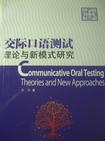交际口语测试理论与新模式研究
出版时间:2010年4月 出版社:中国科学技术大学出版社 作者:薛荣 页数:186 字数:192000
Tag标签:无
内容概要
口语测试是语言测试的一个重要组成部分,但由于其自身的特点和要求,口语测试一直被认为是十分困难的。在口语测试中,一种很常见的测试方法是面试。在传统的面试中,考官向考生提出问题,然后由考生做出回答。这样的测试方式具有很强的可操作性,简单实用,但也有很大的弊病。首先,考官既要和考生对话,又要对考生的口语能力做出判断。考官要同时担任评判者和对话者两个角色。考官很难在专心与考生谈话的同时对考生在测试中的表现进行评分,对其口语能力做出全面的判断。第二,传统的面试形式使考生处于一种非常被动的地位,考生往往比较紧张,很难完全发挥自己的口语水平。第三,传统的口语测试评分过程完全是主观的,一般情况下虽然有描述性的评分标准,但考官在评分过程中的个人好恶和倾向性是难以避免的。 为了改进传统的口语测试形式,本研究尝试将传统的完形填空用于口语测试。所谓完形填空,是1953年由W.L.Taylor。提出的,最初被用来测试母语文章可读性。完形填空被认为是一种测试综合语言能力的可靠、有效、快捷、经济的方式,有很高的信度和效度,在国内外的许多语言测试中都被广泛地运用。对完形填空的各种研究很多,但把完形填空运用于口语测试的研究在国内外尚不多见。 本研究根据交际语言测试的基本理论和语言交际中的Information Gap原理,采用传统的完形填空形式,在口语测试中将听、说、读、写等语言技能结合起来,综合地测试考生的口语水平。在本研究中,作者选取了一位新西兰籍教师的信件为文本,根据完形填空的命题原则和方法,设计了20个空,要求考生在15分钟内完成测试。在该测试过程中,不是考官向学生提问由学生回答,而是考生首先通读短文,然后向考官提出问题,从考官那里获得信息,并把获得的信息填在空白处。测试结束后,考官根据学生所写下来的内容进行评分。
书籍目录
Introduction 0.1 Background and Aims of the Research 0.2 Organization of the DissertationChapter One Theoretical Basis of Communicative Language Testing 1.1 Hvmes: Communicative Competence 1.2 Canale and Swain.the Notion of Communicative Competence 1.3 Bachman.A Framework of Language Competence 1.4 A Framework of Test Method Facets (TMF) 1.5 Other Factors Influencing Language Performance Testing 1.6 Distinguishing Features of Communicative Language Testing 1.7 Integration of the Four Skills 1.8 SummaryChapter Two Communicative Oral Testing 2.1 The Nature of Oral Communication 2.2 Stylistic Features of Spoken Language 2.3 Definition of Speaking Ability 2.4 Types of Oral Tests 2.5 Elicitation Techniques 2.6 Historical Trends and the Present Situation of Oral Testing 2.7 The Difficulty in Testing Speaking Ability 2.8 Issues to Be Considered in Testing Speaking 2.9 SummaryChapter Three Information Theory and Information Gap 3.1 Information and Information Theory 3.2 Information Theory in Linguistics 3.3 Information Gap 3.4 Cloze and Information Gap 3.5 Forms of Information Gap Used as an Oral Testing Technique 3.6 SummaryChapter Four Cloze Test 4.1 Definition of Cloze Test 4.2 Theoretical Basis of Cloze 4.3 Classifications of Cloze 4.4 Other Varieties of Cloze 4.5 Previous Studies of Cloze Test 4.6 Criticism of Cloze Test 4.7 SummaryChapter Five An Experimental Study 5.1 Rationale behind the Research 5.2 Research Questions 5.3 Development of the Oral Cloze Test 5.4 Administering the Test 5.5 Scoring the Test 5.6 SummaryChapter Six Analysis of the Research Results 6.1 Statistical Analysis of the Test Results 6.2 Analysis of the Test Items 6.3 Analysis of the Questionnaire tor Students 6.4 Analysis of the Questionnaire for Teachers 6.5 Correlation of the Oral Cloze Test with Other Courses 6.6 SummaryChapter Seven Validation of the Experimental Test 7.1 Framework of Evaluating a Language Test 7.2 Four Components in the Oral Cloze Test:Reading, Speaking, Listening and Writing 7.3 Face Validity 7.4 Content Validity 7.5 Construct Validity 7.6 Concurrent Validity 7.7 Reliability 7.8 Practicality 7.9 BaCkwash Effect of the Oral Cloze Test on Language Teaching and Learning 7.10 Limitations of the Study and Prospect for Further Research 7.11 SummaryChapter Eight ConclusionAppendicesBibliography
章节摘录
(1)identify the information that is needed for realizing a particularcommunicative goal in a given context; (2)determine what language competences are at our disposal formost effectively bringing that information to achieving thecommunicative goal; (3)ascertain the abilities and knowledge shared by ourinterlocutor; (4)follow the communication attempt; evaluate the extent to thecommunicative goal that has been achieved (Bachman, 1990: 100). Planning strategy enables us to get relevant items from languagecompetence and then formulate a plan whose realization is expected toachieve the communicative goal. Execution strategy can help us to draw on the relevantpsychophysiological mechanisms to implement the plan in the modalityand channel appropriate to the communicative goal and the context(Bachman, 1990: 100-103). Here, the close relation between the three components calls for ourattention. In comprehending or interpreting, assessment, planning andexecution are the same process, which cant be separated.1.3. 4 Psychophysiological Mechanism Psychophysiological mechanism, which used to be ignored in theformer description of communicative language ability for variousreasons, inevitably plays a constant role in communicative activities, forthese activities are always carried out by human beings.
图书封面
图书标签Tags
无
评论、评分、阅读与下载
用户评论 (总计1条)
- 这本书要有一定理论水平才能欣赏!
